CBSE Biology Chapter 11 Transport in Plants class 11 Notes Biology in PDF are available for free download in myCBSEguide mobile app. The best app for CBSE students now provides Transport in Plants class 11 Notes Biology latest chapter wise notes for quick preparation of CBSE exams and school based annual examinations. Class 11 Biology notes on Chapter 11 Transport in Plants class 11 Notes Biology are also available for download in CBSE Guide website.
CBSE Guide Transport in Plants class 11 Notes
CBSE guide notes are the comprehensive notes which covers the latest syllabus of CBSE and NCERT. It includes all the topics given in NCERT class 11 Biology text book. Users can download CBSE guide quick revision notes from myCBSEguide mobile app and my CBSE guide website.
Transport in Plants class 11 Notes Biology
Download CBSE class 11th revision notes for Chapter 11 Transport in Plants class 11 Notes Biology in PDF format for free. Download revision notes for Transport in Plants class 11 Notes Biology and score high in exams. These are the Transport in Plants class 11 Notes Biology prepared by team of expert teachers. The revision notes help you revise the whole chapter in minutes. Revising notes in exam days is on of the best tips recommended by teachers during exam days.
CBSE Revision Notes for Class 11 Biology Download as PDF
CBSE Revision Notes Class 11 Biology Chapter 11 Transport in Plants
Plant transport various substances like gases, minerals, water, hormone and organic solutes to short distance (one cell to another) or long distance as water from roots to tips of stem.
- Long distance transport occurs through vascular system, xylem and phloem called translocation through mass flow.
- The direction of translocation may be unidirectional as in case of water and multidirectional as in minerals and organic solutes.

Simple Diffusion-
- Movement by diffusion is passive and slow along the concentration gradient through permeable membrane.
- No energy expenditure takes place. It occurs in liquid and gases.
- Rate of diffusion are affected by gradient of concentration, permeability of membrane, temperature and pressure.
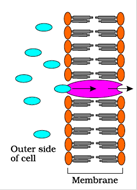
Facilitated Diffusion-
- Lipid soluble particles easily pass through cell membrane but the hydrophilic solutes movement is facilitated.
- For facilitated diffusion, membrane possesses aquaporins or water channels. Aquaporins are membrane proteins for passive transport of water soluble substances without utilization of energy.
- The protein forms channels in membrane for molecules to pass through. The porins are proteins that forms huge pores in the outer membrane of the plastids, mitochondria etc.
- Water channels are made up of eight different types of aquaporins.
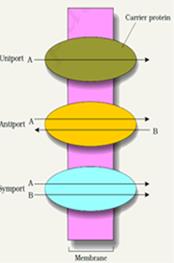
Symport, Antiport and Uniport-
- In Symport, both molecules cross the membrane in the same direction.
- In Antiport, both molecule moves in opposite direction.
- When a molecule moves across a membrane independent of other molecules, the process is called uniport.
Active Transport
- Uses energy to pump molecules against the concentration gradient. It is carried out by membrane proteins.
- In active transport movable carrier proteins are called pumps.
- The pumps can transport substance from low concentration to high concentration. The carrier proteins are very specific in what it carries across the membrane.
Comparison between Transport mechanisms-
| Simple diffusion | Facilitated diffusion | Active transport |
| Special membrane protein is not required. | Special membrane protein is required. | Special membrane protein is required. |
| Not selective | Highly selective | Highly selective |
| Transport do not saturate | Transport saturate | Transport saturate |
| No uphill transport | Uphill transport | Uphill transport |
| No ATP energy is required. | No ATP energy is required. | ATP energy is required. |
Plant Water Relationship
- Water is essential for all physiological activities of plants along with all living organisms. It provide medium for most substances to dissolve in it.
- Protoplasm of cells contains water in which different molecules are dissolved and suspended.
- Terrestrial plants take lot of water and release most of it in form of water vapour by the process of transpiration.
- Water is the limiting factor for plant growth and productivity in both agricultural and natural environments.
Potential ()- is a concept fundamental to the understanding of water movement. Water potential is determined by solute potential () and pressure potential ().
- Water molecules possess kinetic energy. The greater the concentration of water in the system, the greater is its kinetic energy or water potential. So pure water has greatest water potential.
- Water potential is denoted by Greek symbol Psi () and is expressed in pressure unit Pascal (Pa).
- Water pressure of pure water is taken as zero at standard temperature and pressure. A solution has less water potential due to less water concentration.
- The magnitude of lowering of water potential due to dissolution of solute is called solute potential (). Solute potential is always negative. More the solute molecules in the solution lesser the solute potential.
- If a pressure greater than atmospheric pressure is applied to pure water or solution, its water potential decreases. Pressure potential is usually positive. Pressure potential is denoted by ().
- Water potential of a cell is affected by both solute and pressure potential. The relationship is as follows.
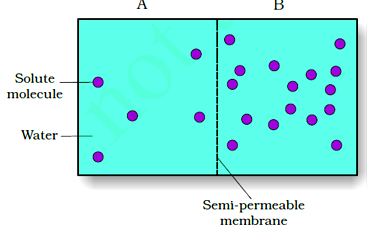
= +
Osmosis is the diffusion of water across a semi-permeable membrane. The net direction and rate of osmosis depends upon the pressure gradient and concentration gradient. Water will move from its region of higher concentration to region of lower concentration until equilibrium is reached.
- Solute A has more water and less solutes so high water potential in comparison to the solution in B container.
- Osmotic potential is the pressure required to prevent water from diffusing. More the solute concentration greater will be the pressure required to prevent water from diffusing it.
- Numerically osmotic pressure is equal to osmotic potential but sign is opposite. Osmotic pressure is the positive pressure while osmotic potential is negative.
- If the surrounding solution balances the osmotic pressure of cytoplasm, the solution is called isotonic.
- If the external solution is more dilute than cytoplasm, it is hypotonic. The cells swell up when placed in hypotonic solution.
- If the external solution is more concentrated than cytoplasm, it is hypertonic. Cell will shrink in hypertonic solution.
- Plasmolysis is the shrinkage of the cytoplasm of the cell away from its cell wall under the influence of hypertonic solution. The pressure of plasmolysis is usually reversible when the cell is placed in hypotonic solution.
- The pressure build up against the wall due to movement of water inside is called turgor pressure. It is responsible for enlargement and extension growth of cells.
- Imbibition is a special type of diffusion when water is absorbed by solid colloids causing them to increase in volume. For example absorption of water by seeds and dry woods. Imbibition is also a kind of diffusion because movement of water is from higher concentration to lower concentration.
- Water potential gradient between the absorbent and liquid imbibed is essential for imbibition.
- Long distance transport of water in plants takes place by mass or bulk flow system. It is the movement of substance in bulk from one point to another as a result of pressure difference between two points.
- The bulk movement of substances through the conducting or vascular tissue of plants is called Translocation. Xylem is associated with translocation of water and mineral salts, some organic nitrogen and hormone from roots to aerial parts of plants.
- Phloem transport organic and inorganic solutes from leaves to other part of plants.
Absorption of water by plants
- Water is absorbed along with mineral solutes by root hairs by diffusion. The absorbed water passes to deeper layer by two pathways.
| Apoplast pathway | Symplast pathway |
|
|
- Most of the water flows in roots via apoplast pathway because cortical cells are loosely packed and offers no resistance to water movement.
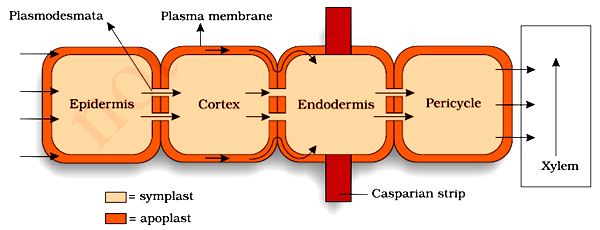
- The inner boundary of cortex, endodermis is impervious to water due to suberised matrix called Casperian strip. Water molecules are directed through wall regions that are not suberised.
- Water flows through the different layers of roots to reach the xylem tissues as follows-

- A mycorrhiza is the symbiotic association between a fungus and angiospermic roots. The fungal filaments forms a network around the young root to have large surface area that help to absorb mineral ions and water from the soil. The fungus provide minerals and waters and roots in turn provide organic and nitrogen containing compounds.
Ascent of saps (Translocation of water)
The upward movement of water from roots towards the tips of stem, branches and their leaves is called ascent of sap.

- Vital force theory was forwarded by J.C.Bose in 1923. This theory believes that the innermost cortical cells of the root absorb water from the outer side and pump the same into xylem channels.
- Root pressure theory was forwarded by Priestley in 1916. Root pressure is positive pressure that develops in the xylem sap of the root of plants. It can be responsible for pushing up water to small heights in plants.
- Loss of water in liquid phase by herbaceous plants from the tips of leaf blades is known as guttation.
- Water rises in tubes of small diameters, kept in vessels having water due to force of surface tension. Similarly water rises up in the walls of xylem channels due to adhesion and cohesion. This theory is called Theory of Capillarity.
- Cohesion Tension theory was put forwarded by Dixon and Joly in 1894. According to this theory water is mostly pulled due to driving force of transpiration from the leaves. The water molecules remain attached with one another by cohesion force. The water molecule does not breaks in vessels and tracheid due to adhesive force between their walls and water molecules. On account of tension created by transpiration, the water column of plant is pulled up passively from roots to great heights.
- Transpiration is the loss of water in the form of water vapour from aerial parts of plants. The following purpose is fulfilled by transpiration-
- Creates transpirational pull for absorption and transport in plants.
- Supplies water for photosynthesis.
- Transport minerals and salts from soil to other parts of plant.
- Cool the leaves and maintain their shape and size.
- Photosynthesis is limited by available water. plants are twice as efficient as plants in term of fixing carbon. Although plants uses half as much water as plants for the same amount of fixed.
Uptake and transport of mineral nutrients
- Most of the minerals enter the roots by active absorption into the cytoplasm of epidermal cells because-
- Minerals are present in the soil as charged particles (ions) which cannot move across cell membranes.
- The concentration of ions in soil is usually lower than concentration in roots.
- Active absorption needs energy in form of ATP. Active uptake of ions is also responsible for water potential gradient in roots.
- Transport proteins of epidermal cells are control point where quantity and type of solutes that reach the xylem is adjusted.
- The ions that reaches to xylem by active or passive transport moves further upward along with transpirational pull.
- The chief sink of mineral elements are growing region of plants like apical meristem, young leaves, growing flower and fruit, and the storage organs.
- Minerals are frequently remobilized from older senescing part of the plants to young growing parts of plant.
- The elements most readily mobilized include phosphorus, sulphur, nitrogen and potassium. The element like calcium is not mobilized as it is the structural components of plant body.
Phloem transport: Flow from Source to Sink
- Food (sucrose) is transported by phloem from source to sink. The part of plant that synthesize the food is called source and part where food is used or stored is called sink.
- The source and sink can be reversed by the plants depending upon the season or plant’s need. So, the direction of movement in the phloem is bi-directional.
- Phloem sap is mainly water and sucrose but other sugars, hormones and amino acids are also translocated through it.
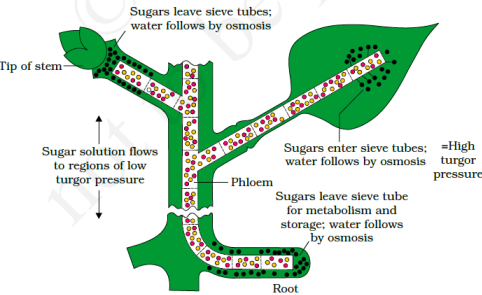
Pressure flow or Mass flow hypothesis
- It is the most accepted theory for the translocation of sugar from source to sink. Glucose is prepared at source by photosynthesis which is converted into disaccharides (sucrose). Sucrose moves into companion cells and then into sieve tube cells by active transport.
- Loading of phloem at source creates a water potential gradient that facilitates the mass movement in the phloem.
- Sieve tube cells of phloem forms a long column with holes in their wall called sieve plates. Cytoplasmic strands pass through the hole in the sieve plates to form continuous filament. Hydrostatic pressure developed in sieve tube cells moves the sap in the phloem.
- At sink, incoming sugar is actively moved out of the phloem as complex carbohydrates. The loss of solute produces a high water potential in the phloem and water passes out and returning into xylem.
Transport in Plants class 11 Notes
- CBSE Revision notes (PDF Download) Free
- CBSE Revision notes for Class 11 Biology PDF
- Revision notes Class 11 Biology – CBSE
- CBSE Revisions notes and Key Points Class 11 Biology
- Summary of the NCERT books all chapters in Biology class 11
- Short notes for CBSE class 11th Biology
- Key notes and chapter summary of Biology class 11
- Quick revision notes for CBSE exams
CBSE Class 11 Revision Notes and Key Points
Transport in Plants class 11 Notes Biology. CBSE quick revision note for class 11 Mathematics, Physics, Chemistry, Biology and other subject are very helpful to revise the whole syllabus during exam days. The revision notes covers all important formulas and concepts given in the chapter. Even if you wish to have an overview of a chapter, quick revision notes are here to do if for you. These notes will certainly save your time during stressful exam days.
- Physics
- Chemistry
- Mathematics
- Biology
- Accountancy
- Economics
- Business Studies
- Computer Science
- Informatics Practices
- Geography
To download Transport in Plants class 11 Notes, sample paper for class 11 Chemistry, Physics, Biology, History, Political Science, Economics, Geography, Computer Science, Home Science, Accountancy, Business Studies and Home Science; do check myCBSEguide app or website. myCBSEguide provides sample papers with solution, test papers for chapter-wise practice, NCERT solutions, NCERT Exemplar solutions, quick revision notes for ready reference, CBSE guess papers and CBSE important question papers. Sample Paper all are made available through the best app for CBSE students and myCBSEguide website.
- The Living World class 11 Notes Biology
- Biological Classification class 11 Notes Biology
- Plant Kingdom class 11 Notes Biology
- Animal Kingdom class 11 Notes Biology
- Morphology of Flowering Plants class 11 Notes Biology
- Anatomy of Flowering Plants class 11 Notes Biology
- Structural Organisation in Animals class 11 Notes Biology
- Cell Structure and Functions class 11 Notes Biology
- Biomolecules class 11 Notes Biology
- Cell Cycle and Cell Division class 11 Notes Biology
- Mineral Nutrition class 11 Notes Biology
- Photosynthesis in higher plants class 11 Notes Biology
- Respiration in Plants class 11 Notes Biology
- Plant Growth and Development class 11 Notes Biology
- Digestion And Absorption class 11 Notes Biology
- Breathing and Exchange of Gases class 11 Notes Biology
- Body Fluids And Circulation class 11 Notes Biology
- Excretory Products and their Elimination class 11 Notes Biology
- Locomotion and Movement class 11 Notes Biology
- Neural Control and Coordination class 11 Notes Biology
- Chemical Coordination and Integration class 11 Notes Biology
- Cell Structure and Functions class 11 Notes Biology

Test Generator
Create question paper PDF and online tests with your own name & logo in minutes.
Create Now
Learn8 App
Practice unlimited questions for Entrance tests & government job exams at ₹99 only
Install Now